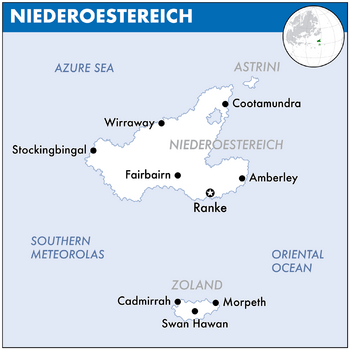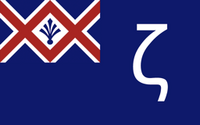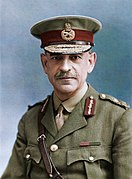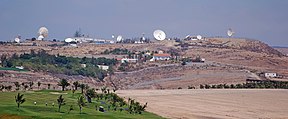Niederoestereich
National Comrades of Niederoestereich Niederoestereich (Alemannic) Astrini (Oharic) | |
|---|---|
Motto: Communitas, Identitas, Stabilitas (Community, Identity, Stability) | |
 Map of Niederoestereich | |
| Capital | Ranke |
| Demonym(s) | Niederoestereichian, Astrinese |
| Government | Unitary council republic |
| John Monash | |
• Premier | Maputi White |
| Legislature | House of Representatives Senate |
| Population | |
• 2020 census | 14,906,117 |
| Currency | Reichsmark (NRM) |
| Antipodes | Yeosan |
The National Comrades of Niederoestereich, commonly known as Niederoestereich and sometimes also called the State of Niederoestereich, is a sovereign state situated in the southeastern region of Europa on Eurth. Niederoestereich shares borders with Orioni to the north, Burkini and Sunset Sea Islands to the east, and Bainbridge Islands to the west. With an estimated population of nearly 15 million as per the 2020 census, the country's vibrant capital is the city of Ranke. Governed as a unitary council republic since 1901, the nation's current Chancellor is John Monash, while the Premier is Maputi White. Niederoestereich's legislative powers are vested in a bicameral parliament comprising the House of Representatives and the Senate. The country's official currency is the Reichsmark (NRM). Niederoestereich's antipodal point is located in Yeosan. The nation is renowned for its strong ties with neighbouring countries and is a founding member of the Entente of Oriental States.
Etymology
The name "Niederoestereich" originates from Old Buranic, a language of the Buran people, an ethnic group known for their seafaring skills. The term "Niederoestereich" is a composite of two words, "nieder" and "oesten", translating to "lower" or "southern" and "eastern", respectively. The name essentially means the "lower east" or "southern east", which aptly describes the geographical location of the country in the southeastern part of Europa.
Historical records suggest that the name "Niederoestereich" was first documented around the 1200s. The Buran sailors, renowned for their seafaring skills, were believed to have coined this term when they first navigated to these tropical islands. The Buran were engaged in explorations across Europa, and their naming conventions usually drew heavily from geographical features or location markers, which is evident in the case of Niederoestereich.
In the Oharic language, another major linguistic group on the island, the name for Niederoestereich is "Astrini". The exact origins and meaning of this term remain a subject of academic debate, but it is believed that it might be related to the Oharic word for "star". This could be interpreted as a reference to the island's beauty or a nod to the vital role celestial navigation played in discovering the island.
While the country is known officially as the ‘National Comrades of Niederoestereich’, and colloquially as Niederoestereich, the name Astrini is still in use among the Orinese minotiry within the nation. It serves as a testament to the nation's rich linguistic history and cultural diversity. The dual names for the country, each with a distinct linguistic origin, provide a fascinating insight into the convergence of cultures and languages that have shaped Niederoestereich's history and identity.
Geography
Niederoestereich is a tropical country located in the southeastern region of Europa on Eurth. It is part of the Meteorolan archipelago, at the edge of the enormous Oriental Ocean. The country is made up of three main islands: Astrini, Niederoestereich, and Zoland. Given its location at the eastern end of the Meteorolan islands chain, Niederoestereich has important geographical and strategic significance. Neighbouring countries include Orioni to the north, Burkini and Sunset Sea Islands to the east, and Bainbridge Islands to the west. Niederoestereich's location also influences its economic activities, with fishing and tourism particularly significant in coastal areas. Moreover, the diverse landscapes across the three islands provide for a variety of agricultural activities, contributing to the country's food security and export income.
General characteristics
The country's landscape is immensely varied. The coastal areas are dominated by long, sandy beaches while inland regions present a tapestry of tropical rainforests, rolling hills, and fertile plains. The northwest region of the country gives way to the towering Dashtoparan mountain range, which is renowned for its rich biodiversity and breathtaking vistas. Numerous rivers crisscross the land, providing vital freshwater resources for both population centres and agriculture.
Niederoestereich's climate is predominantly tropical oceanic, marked by year-round high temperatures, ample sunshine, and frequent rainfall. The trade winds lend a moderating influence, providing relief from the intense heat and distributing rainfall evenly throughout the year.
Despite the country's tropical climate and rich natural resources, preservation of the environment is a significant priority in Niederoestereich. The country has numerous national parks and protected areas aimed at conserving its unique flora and fauna, and efforts are continually made to promote sustainable practices in agriculture, industry, and urban development.
The island is a hotspot of biodiversity.
Coconut crabs are protected in Niederoestereich.
Islands
The northernmost island, Astrini, is the smallest of the three. Despite its size, Astrini is notable for its lush, vibrant rainforests, and unique biodiversity. Its coastal regions are characterised by white sandy beaches and coral reefs that are home to a wide variety of marine life, making it a popular spot for diving and ecotourism. The interior of Astrini is hilly with many small, fast-flowing rivers and waterfalls.
The largest and central island, also named Niederoestereich, is the economic and political hub of the country, housing the capital city, Ranke. This island features a diverse landscape that includes mountain ranges, rivers, vast rainforests, and extensive coastal plains. The western coast of the island is particularly known for its beautiful beaches, while the eastern coast is home to impressive cliffs and rugged terrains. The highest point in the country is Mount Kaelen, located on this island, reaching an elevation of 2,981 metres above sea level. The island of Niederoestereich is also renowned for its biodiversity, with several national parks and protected areas established to conserve its unique flora and fauna.
Zoland, the southernmost and second smallest island, has a diverse landscape with an interior dominated by mountains and forests, while its coasts are marked by stunning beaches and large mangrove forests. Zoland is also noted for its vibrant cultural heritage, with numerous indigenous communities maintaining traditional ways of life.
Each of the three islands boasts distinct geographical features and ecosystems, which contribute to the country's rich biodiversity. Niederoestereich's climate is predominantly tropical oceanic, characterised by high temperatures, substantial rainfall, and trade winds that moderate the climate.
Cities
The capital city, Ranke, is located on the southeastern coast and is a bustling hub of political, economic, and cultural activity. Other significant cities include Wirraway, known for its major trading port and shipyards, and Amberley, a leading centre of education and technology. Niederoestereich is divided into four states, each boasting distinctive geographical and cultural features.
History
Prehistory
Niederoestereich's rich and complex history dates back as early as 80,000 BCE, when Azano-Marenesian peoples, known as the Meteorolan settlers, first made their home on the island. They thrived in the region for thousands of years, developing distinct cultures and societies. Evidence of their early settlements and sophisticated stone tools can still be found on the island today.
Chulese period
From the 5th century BCE until the 2nd century CE, Niederoestereich was part of the Chulo Empire, a dominant thalassocracy in South Europa. The island was an important outpost in the vast Chulese maritime network, playing a critical role in trade and naval defense. The Chulese period saw the construction of advanced infrastructure, fortified settlements, and the flourishing of local arts and crafts influenced by the broader Chulo culture.
Part of the Pearl Road
After the fall of the Chulo Empire in the 2nd century CE, the island went through several periods of rule by different powers. By the 400s, the island was known for its rare gemstones, positioning it on the historic Pearl Road. In 429 CE, gem trader Rakashan Tholnaar became the wealthiest merchant in the region, with his rare Niederoestereichian pearls sought after in markets across Eurth.
Buran period
After the Orinese Civil War ended in 1224, the island was awarded to Buranian mercenaries in return for their support. Buranian commander Hardrada Sigurdsson and his men settled there, ruling it as an independent kingdom and using the island primarily as a penal colony and strategic outpost. In 1256, Sigurdsson's son, Einar Hardradason, continued his father's legacy by solidifying the rule of several dynastic houses.
Orinese period
The last ruling dynasty, the Löwenburgs, ended in 1754 when Duke Friedrich Löwenburg died without an heir, leading to Niederoestereich reverting to Orinese control and becoming an outpost of its colonial empire.
In 1801, the country witnessed a sectarian uprising against the Orinese rulership, led by the charismatic rebel leader Anteo Zorzi, but this was quickly suppressed. However, Zorzi's martyrdom ignited the flame of rebellion in the Niederoestereichian people.
The radical socialist group Slazyu attempted to seize control of the Royal Palace in Ranke in 1865, marking the so-called 'Slazyu Revolt'. The rebellion was quelled by Loyalist forces led by General Johannes Schwertfeger, and the key members of Slazyu were exiled.
Independence
The turn of the century saw increased nationalist uprisings.[a] The nationalist uprisings of the 1890s were in response to the perceived exploitation and marginalisation of the native Niederoestereichian people by the ruling Buran elites.
The nationalist uprisings gained momentum towards the end of the 19th century, leading to the Declaration of Independence in 1901 led by Karl Hohenberg, who would become the first Chancellor of Niederoestereich. The declaration marked the country's independence from Orioni and the establishment of the unitary council republic.
In the 1920s, the "White Niederoestereich Policy" was passed by Chancellor Reinhold Bürkl to maintain the culture and identity of Niederoestereich, aiming to control foreign influence after independence.
Contemporary era
Influenced by global political events, Niederoestereich transitioned into a democracy with right-wing leanings in the 1940s under the leadership of Chancellor Konrad Aden.[1] The rise of democracy marked a significant step in the country's political evolution, fostering increased political participation and the growth of civil liberties.
A significant turning point came in 2005 with a swift revolution led by the Army, workers, and the middle class, resulting in a new political structure, heavily influenced by nationalist and communist principles. The revolution, led by John Monash, brought about a significant change in the country's name to "National Comrades of Niederoestereich" and established a new political order that still governs the country today.[1]
Politics
Government
Niederoestereich is a unitary council republic, with a government responsible for making and enforcing the laws that govern the country. This government is divided into three branches - the executive, legislative, and judicial - which work together to ensure the smooth functioning of the government and the protection of the rights and freedoms of the people of Niederoestereich. The head of state is Chancellor John Monash, known for his fiery temper and unsuccessful advocacy for conscription at the start of the 2005 revolution.[1] The head of government is Premier Maputi White. The legislative branch consists of the House of Representatives and the Senate, both elected by the people of Niederoestereich. The House represents the people and passes laws, while the Senate serves as a reviewing and advising body. The judicial branch is independent from the other two and is responsible for interpreting and enforcing the laws of the country through a system of courts, including the Supreme Court. It ensures that the laws of Niederoestereich are followed and enforced fairly.
- Head of State: Chancellor John Monash
- Head of Government: Premier Maputi White
- Minister for Transport and Regional Services: Hon. H. Murray
- Treasurer: Hon. C. Anderson
- Minister for Trade: Hon A. Blackburn
- Minister for Foreign Affairs: Hon. J. Partridge
- Minister for Defence: Hon. H. Throssell
- Minister for Finance and Administration: Hon. J. Maxwell
- Minister for Health and Ageing: Hon. R. Simpson
- Attorney-General: Hon. R. Keliher
- Minister for the Environment and Heritage: Hon. C. Jeffries
- Minister for Communications, Information Technology and the Arts: Hon. A. Hall
- Minister for Agriculture, Fisheries and Forestry: Hon. J. Woods
- Minister for Immigration and Multicultural Affairs: Hon. J. Dywer
- Minister for Education, Science and Training: Hon. W. Dunstan
- Minister for Family and Community Services: Hon. C. Pope
- Minister for Industry, Tourism and Resources: Hon. A. Gurney
- Minister for Employment and Workplace Relations: Hon. R. Grieve
- General of Combined Forces: General J. Hennessy
- Head of Niederoestereichian Secret Intelligence Organisation (NSIO): Major. D. Zhukov
Military
The Niederoestereichian Defence Force (NDF) is responsible for the defence of Niederoestereich. Most of the military budget is directed towards the army, then navy, air force and finally space projects. Niederoestereichs main attribute is its army, although only made up of volunteers with a small professional army. Her army infantry is mainly used as shock troops, which enjoys good morale in most situations. There are armoured cavalry regiments, although none professional they still rival if not better their counterparts. Its naval is relatively small, since before 1900; its former motherland had taken care of defence. Niederoestereichian navy is mainly late 20th century frigates, destroyers, minelayers and corvettes, no dreadnoughts or heavy cruisers. Niederoestereich has a limited air force. In 2005, Niederoestereich launched it first space vehicle.[1]
The command structure of the NDF is quite simple: the Head of State is supreme commander and decides were the forces are deployed, while the General of the Combined Forces is promoted from one of the three leaders of each repective defence branch. These positions are held by respectively Chancellor John Monash and General J. Hennessy from the Niederoestereichian Army. Although the Niederoestereichian military may not contain the latest and greatest technology, the training programmes and officer training greatly enhance available resources. Pure; basic soldiering is taught without having to rely on technology. In war zones, all ranks attend briefings, including cooks, as so if the officers are taken out, the force can carry on sufficiently.
WIP
- Astrini, Niederoestereich and Zoland Army Corps (ANZAC)
Foreign relations
Niederoestereich is a member of the Entente of Oriental States and the Group of Island Nations. It maintains good diplomatic relations with Orioni, its former coloniser.
Economy
Niederoestereich has a developed, industrialized economy with a strong service sector and well-established manufacturing industries, including the production of automobiles and machinery. The country has low unemployment rates and a high standard of living. Its citizens are known for their hardworking nature and higher basic wages compared to many other countries. Niederoestereich has a high level of foreign trade and is home to numerous international companies. The country places a strong emphasis on education and training, which has contributed to a highly skilled workforce. Niederoestereich maintains its own currency, the Niederoestereichian Reichsmark (NRM), and the port city of Wirraway is the leading commercial and industrial city in the country.
Transport
Niederoestereich has an extensive and well-developed transportation network, which includes road, rail, air, and sea transport. The country has a vast network of highways and motorways, which connect all major cities and regions. Rail transport is also widespread and includes both passenger and freight services. Niederoestereich's airports offer domestic and international flights, and its seaports handle large volumes of cargo and passenger traffic.
Media
Niederoestereich has a vibrant and diverse media landscape, which includes newspapers, television, radio, and digital media. The country's media is known for its robustness, independence, and commitment to the principles of freedom of speech and the press. The public broadcaster, Niederoestereichian Broadcasting Corporation (NBC), is funded by the government but operates independently. It provides a wide range of programming, including news, current affairs, sports, entertainment, and children's programming.
Demographics
Niederoestereich has a relatively high life expectancy, according to data from the Assembled Nations. The country has a significant immigrant population, with many people moving to Niederoestereich for work, study, or family reasons. It also has an Indigenous population with a long and rich history on the land. Niederoestereich has a high level of urbanization, with a majority of the population living in cities and towns. The largest cities in the country are Ranke, Wirraway, and Amberley. Niederoestereichians have historically viewed themselves as an egalitarian society, with a distrust of the rich and powerful. This belief continues in the form of the "tall poppy syndrome," where successful individuals or organizations are criticized or resented for their success. This cultural phenomenon is common in many societies and is often seen as a way to level the playing field and prevent social inequality. Overall, it is a diverse country with a rich history and culture, and a strong focus on education and social equality. It is known for its beautiful beaches, tropical rainforests, and welcoming people.
Language
The language combines a mocking disrespect for established authority, particularly if it is pompous or out of touch with reality, with a distinctive upside-down sense of humour. For instance, Niederoestereichians take delight in dubbing a tall man “Shorty”, a silent one "Rowdy", a bald man “Curly”, and a redhead, of course, is “Blue”. Politicians, or “pollies”, be they at the state or federal level, are universally disliked and distrusted.
Religion
Niederoestereich is a secular country with freedom of religion. The major religions in the country are Christianity, Buddhism, and Hinduism. There is also a significant number of people who identify as having no religion. Despite the religious diversity, Niederoestereichians are generally tolerant and respectful of each other's religious beliefs.
Education
Education in Niederoestereich is highly valued and is mandatory for all children aged between six and sixteen years old. The education system is divided into three levels: primary education, secondary education, and tertiary education. Primary education lasts for six years and includes basic skills such as reading, writing, and arithmetic. Secondary education lasts for six years and is divided into lower and upper secondary. Lower secondary education focuses on general education, while upper secondary education focuses on specific areas of study and prepares students for university or vocational training. Tertiary education includes universities and vocational institutions. Niederoestereich's universities are highly ranked internationally and offer a wide range of courses in areas such as humanities, science, and technology.
Healthcare
Niederoestereich has a universal healthcare system, which is funded by taxpayers and managed by the government. All citizens and permanent residents have access to free or subsidised healthcare services, including general practitioner services, hospital care, and prescription medications. The healthcare system in Niederoestereich is known for its high quality of care and its emphasis on preventive healthcare.
Culture
The Niederoestereichian culture has historically been a masculine one, forged on the hardship of early settlers, and later on the heroism of the Niederoestereichian soldiers in past conflicts. “Mateship”, or loyal fraternity, has reigned supreme. This also explains why the more aggressive forms of sport enjoyed by all. Niederoestereichians are passionate about sports, and it forms a major part of the country's culture. Cricket is the most popular sport.
Niederoestereichians have traditionally had a very strong “underdog” attitude, that is, they will support those who appear to have the lesser hand, so long as Niederoestereich is not involved. This is evident in Niederoestereich's involvement in the Second Tamurin War, supporting the cause of the Imperials. The country shares distant cultural ties with Tamurin, a country which was similarly dominated by a Buranian elite for several centuries.
Niederoestereichians, are relaxed, tolerant, easy-going and yet cling dearly to the fundamental importance of common-sense justice, or to use the classic expression, a “fair go”. It is the land of the long weekend: a country that declares a universal holiday for a horse race, that pioneered the eight-hour working day, that takes pride in never working too hard and yet idolises the “little battler” who sweats away for a small reward. Niederoestereichians respect “hard yakka”; to be “flat out like a lizard drinking” is to be extremely busy, or sometimes the exact opposite. Niederoestereichians are said to make great sportsmen and superb soldiers.
1There are a number of public holidays and festivals, which reflect the country's history, culture, and values. Major holidays include Niederoestereich Day, which commemorates the establishment of the first permanent European settlement in the country, and ANZAC Day, which honours the members of the Astrini, Niederoestereich and Zoland Army Corps (ANZAC) who served and died in all wars, conflicts, and peacekeeping operations. Major festivals include the Niederoestereich Festival, which celebrates the country's arts and culture, and the Niederoestereich International Film Festival, which showcases the best in local and international cinema.
Notes
- ↑ OOC. WIP: have a look at the ʻUrabi revolt.
References
- ↑ 1.0 1.1 1.2 1.3 The National Comrades of Niederoestereich (europans.com)













